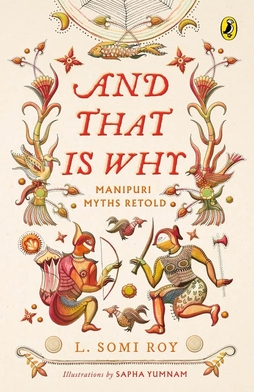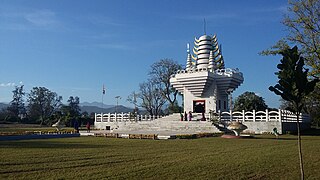Related Research Articles

Sanamahism, also known as Meiteism, or Lainingthouism is an ethnic religion of the Meitei people of Manipur, in Northeast India. It is a polytheistic religion and is named after Lainingthou Sanamahi, one of the most important deities of the Meitei faith. Sanamahi is the eldest son of the supreme god Sidaba Mapu and the supreme goddess Leimarel Sidabi. Traditionally every Meitei household, irrespective of the religion, worships Sanamahi and Leimarel Sidabi. Sanamahism does not have a religious head but has a body, the Maru Loishang, that oversees the main religious activities and governs all affairs of the religion, including the conduct of priest and priestess. The Maru Loishang also acts a court for religious disputes. There are three main departments under the Manu Loishang, namely, the Amaiba Loishang, the Pena Asheiba Loishang, and the Amaibi Loishang. These departments have existed since the reign of King Meidingu Hongnemyoi Khunjao Naothingkhong of Manipur in 662 AD. Sanamahi is the eldest son of the supreme god Sidaba Mapu and the supreme goddess Leimarel Sidabi.

Meitei literature, also known as Manipuri literature, is literature written in the Meitei language of Manipur. An ancient institution of learning, the Luwang Nonghumsang, later known as the Pandit Loishang, collected sources of indigenous Meitei knowledge and philosophy until the 18th century. Writing by Meiteis is assumed to go back to the Kingdom of Kangleipak in the early 12th century. The Meitei script is a Brahmic abugida. It is known only from the Puya manuscripts discovered in the first half of the 20th century. Manuscripts of the 18th and 19th centuries were written using the Bengali alphabet. The existence of the Meitei script in the 15th-century hinges on the authenticity of an inscription dated to the reign of Senbi Kiyamba. The first printed Manipuri book, Manipurer Itihas, appeared in 1890 from the Baptist Mission Press, Calcutta. Though the kings of Manipur had established contact with the British from the middle of the eighteenth century onward the real impact of the contact came much later. Johnstone Middle English School, based on the western system of education, was started in 1885 at Imphal, and in 1891 Manipur lost its independence to the British. British domination facilitated the introduction of new systems in the civil, political and educational spheres, which hastened the process of modernization in Manipur, exposed as it was to new ideas and influences.

Pakhangba is a primordial deity, often represented in the form of a dragon, in Meitei mythology and Sanamahism, the indigenous religion of Manipur. He is depicted in the heraldry of Manipur kingdom, which originated in paphal, mythical illustrations of the deity. It is believed that the ancestor of one of the Meitei clans manifested himself as the Pakhangba.
Hiyangthang is a town in Indian state of Manipur. It is best known for the Hiyangthang Lairembi Temple, a Meitei shrine dedicated to ancient Meitei goddess Irai Leima. It is located in Imphal West district.

Nongshaba is a lion god in Sanamahism and Meitei mythology. He is also regarded as a king of the gods. He is credited with producing light in the primordial universe and is regarded as the maker of the sun. He is worshipped by the people of both the Ningthouja clans as well as the Moirang clans. Nongshaba was worshipped by the people of Moirang clan as a lineage deity and regarded as the father of the god Thangching. He is the greatest of the Umang Lais but he made his only son Thangching the chief deity of Moirang.
The Hiyangthang Lairembi Temple is an ancient temple of Goddess Hiyangthang Lairembi of Meitei religion (Sanamahism). The sacred building is situated on the hilltop of Heibok Ching in the Hiyangthang, Manipur. Thousands of devotees thronged at the holy site during the festival time of Lai Haraoba of Sanamahism as well as Durga Puja of Hinduism.

Meitei inscriptions are Meitei language inscriptions cut into stone slabs. They are a major source of information about the ancient history of the Meitei people and the kingdom of Kangleipak. They are mainly found in the hills as well as the plains of present-day Manipur. They were written using either the Meitei script or the Bengali script.

Irai Leima is a goddess in Sanamahism, the indigenous religion of Manipur. She is the goddess and the divine female personification of water and aquatic life. She is the consort of Irai Ningthou. Both are regarded as the divine spirits of water bodies. She is also considered to be in charge of diseases.

Nongpok Ningthou, also known as the Sovereign of the East or King of the East, is a deity in Sanamahism, the indigenous religion of Manipur. He is the ruling guardian deity of the eastern direction. Legend says Nongpok Ningthou and his consort Panthoibi were united in the Nongmaiching Ching mountains. Later, they were worshipped as the civilization giving deities in Meitei religion.

Konthoujam Tampha Lairembi or Chingphuron Konthousu is a goddess in Sanamahism, the indigenous religion of Manipur. She was formerly a mortal being belonging to the Haorok Konthou clan.

Khoriphaba is a God in Sanamahism, the indigenous religion of Manipur. He is the son of Sky God Salailen and the Goddess Konthoujam Tampha Lairembi. He came down from heaven to earth to search for his mother and then for a bride. He is best known for wrestling with Loyalakpa in the Lai Haraoba festival. He is also a Sagol Kangjei(polo)-playing God.

Yumjao Leima or Yumjao Lairembi or Yumjao Lairemma is the mother goddess of house, household, royalty, rule and power in Meitei mythology and religion. She is designated as the all time ruling Queen Mother. Legend says she assumes a human form in white clothes and blesses kings. She is one of the divine incarnations of Leimarel Sidabi.

Koujeng Leima is a goddess in Sanamahism, the indigenous religion of Manipur. She is a wife of God Koupalu. She was a tribal woman, but later worshipped by the Meiteis as a goddess. She is one of the nine goddesses (laibenthous) who participated in the festival of God Thangjing.

Ichum Lairembi is a goddess in Sanamahism, the indigenous religion of Manipur. Her major cult centre of worship is located in Khurkhul.

And That Is Why... Manipuri Myths Retold is a children's book based on 12 stories from the Meitei mythology of Manipur, written by L. Somi Roy and published by Penguin Random House India. It was launched by Member of Parliament Rajya Sabha and titular King of Manipur Leishemba Sanajaoba at the palace compound, Imphal on 21 June 2021. The stories are adaptations of tales found in the puyas.
Konthoujam may refer to:

The culture of Meitei civilization evolved over thousands of years, beginning in Ancient Kangleipak, continuing most notably into Medieval Kangleipak, while influencing the neighboring states and kingdoms, till present times.

Women have significant roles in different elements of Meitei culture, including Meitei dances, Meitei festivals, Meitei folklore, Meitei folktales, Meitei literature, Meitei mythology, Meitei religion, etc.
References
- 1 2 3 4 Meitei, Sanjenbam Yaiphaba; Chaudhuri, Sarit K.; Arunkumar, M. C. (25 November 2020). The Cultural Heritage of Manipur. Routledge. pp. 171–176. ISBN 978-1-000-29629-7.
- 1 2 3 Birajit, Soibam (1 December 2014). Meeyamgi Kholao: Sprout of Consciousness. ARECOM ( Advanced Research Consortium, Manipur).
- ↑ Devi, Nunglekpam Premi (14 April 2018). A Glimpse of Manipuri Literary Works. FSP Media Publications.